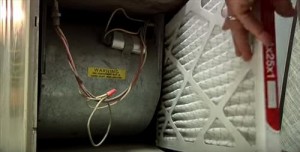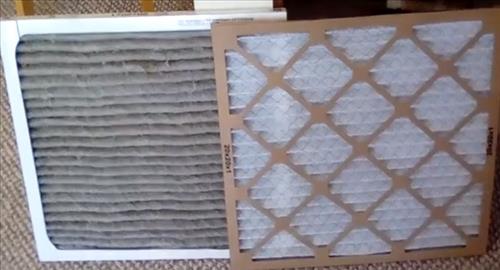
Replacing a furnace filter is often not on the top of the to-do list.
It can be overlooked until the furnace is not working properly or the air becomes less clean.
People with allergies are often the first to notice when a furnace filter has become dirty and needs to be replaced.
And just as important, a dirty filter can hinder a furnace from working properly.
As an HVAC tech, I have been on many furnace calls only to get there to find out the filter is dirty.

When a filter becomes dirty less-and-less air can circulate inside a furnace and into a home.
A dirty filter raises the temperature inside a furnace Heat Exchanger, which has a High Limit Switch that will shut down a furnace when it becomes too hot.
The good news is this is all easily fixable by simply replacing a filter with a new one.
How are Furnace Filters are Rated?
There are two main ways filters are rated with the MERV rating and MPR rating
- MERV Rating
- (MPR) Microparticle Performance Rating
The MERV rating was created by ASHRAE as a rating system for filters and measuring the size of debris that can pass through a filter at the micron level.
The rating system is measured by a number between 1-16, with 16 being the best and 1 being the worst.
MPR is a new rating created by the 3M system and has filters that have smaller filtration holes than the MERV rating can rate.
This does not make MPR-rated filters better than MERV-rated filters but, in some cases, can measure smaller diameter holes than MERV can.
Here is a comparison between the two numbers.
MPR Rating vs. MERV Rating
| MPR Rating | MERV Rating |
|---|---|
| 300 | 6 |
| 600 | 8 |
| 1000 | 11 |
| 1200 | 11 |
| 1500 | 12 |
| 1900 | 12 |
| 2200 | 12 |
Types of Furnace Filters
HVAC Filters are made with a different manufacturing process that has differently rated filters.
Here are the main types of filter technology and their rating.
- Disposable Fiberglass
- Disposable Pleated
- Disposable Electrostatic
- Washable Permanent Electrostatic
- High-efficiency pleated
MERV rating 2-4
These are often the cheapest filters sold and have a low MERV rating. If you need something cheap to simply get by with, these are for you.
They don’t clean the air much but simply keep out big debris particles that can clog up the components inside a furnace.
MERV Rating 5-10
These types of filters are a step up from the disposable fiberglass types.
They do cost more but do a good basic job cleaning the air in a home. Disposable Pleated filters are the most commonly used home filters. While there are better filters, they do work well in removing most of the toxins from the air.
MERV Rating 8-12
Electrostatic filters clean the air since they become positively charged by static electricity.
This static charge makes them better at catching small particles that pass through them.
There are both disposable and washable electrostatic filters, with washable the most popular since they can be continuously reused.
MERV Rating 8-12
These work the same as the disposable electrostatic filters but are re-washable.
Since they are reusable, they can last many years and save money in the long term.
MERV Rating 11-16
Made from 4-5 inches of cotton or similar material makes, these types of filters have the highest MERV rating.
If you need the highest quality furnace filter with the cleanest air, then this is the type to get.
Since they are thick, they don’t fit into all furnace return air slots, so be sure to check your furnace dimension to see if one will fit into it.
How to Replace a Furnace Filter
- Measure the Width.
- Measure the Length.
- Check how thick the filter is, with most roughly 1 inch thick.
- Buy a replacement that matches your filter size.
Furnace filters are replaced by measuring the width by the length.
So a filter that measures 20 inches long by 25 inches wide would be replaced by a 20 X 25 filter.
Depth can also be important on some furnaces, with most being roughly 1 inch deep.
How Often Does a Filter Need Changing?
How often a filter is replaced depends on how fast it becomes dirty and clogged up.
A home that is located in the desert location will become dirty quicker than a home at a higher elevation.
The same can be said about a home with pets compared to a home with none.
Most homes can go 2-3 months between filter changes.
So Which Filter Is The Best To Buy?
This depends on a person along with cost and how clean the air is wanted.
Filter prices can vary from cheap to expensive depending on what is needed.
Someone who is allergy-prone will likely want a better filter to help keep attacks from happening.
If your home needs the air very clean, there is also a whole-home air filter that works well and boosts air quality.
The arrow indicating airflow should always point towards the blower motor correct?
Thank you! Really helpful just changed my filter in less than a minute
Since no home owner has ay idea what their total static pressure is on their furnace or how much pressure drop the 1 inch filter they just bought will cause, the ONLY safe choice is to use a premium fiberglass filter like a Glasfloss “PTA” filter or a Flanders Fiberglass filter.
I have seen many furnaces over heat even with the lowest MERV rating pleated filters so fiberglass is the only way to go in 1 inch filters.
need supplier for Honeywell High efficient geothermal
filters
where to order honeywell 2 inch by 20 by 25